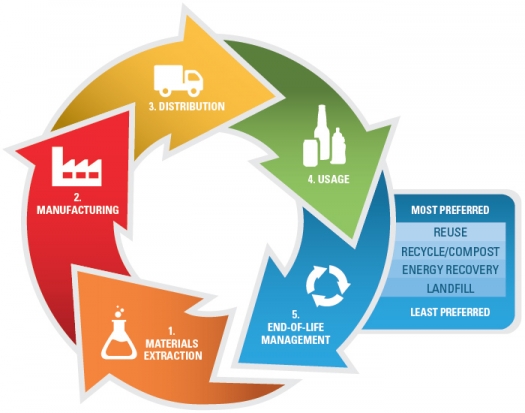Climate Change and the Life Cycle of Stuff
Have you ever considered where the food we eat and the goods (stuff) we use come from, or where they go when you finish with them? Everything we use goes through a life cycle, and each stage of the life cycle has environmental impacts, including climate change. However, reducing the use of materials in every stage of the life cycle minimizes the environmental impact associated with the stuff we use.

Click on the links below to learn about greenhouse gas emissions over a product's life cycle and to find out what you can do to reduce your carbon footprint.
- Stage 1: Materials Extraction
- Stage 2: Manufacturing
- Stage 3: Distribution
- Stage 4: Usage
- Stage 5: End-of-Life Management
Stage 1: Materials Extraction
All products are made from materials found in or on the earth. “Virgin” or “raw” materials, such as trees or ore, are harvested directly from the earth, then transported and processed. These activities use a large amount of energy, and burning fossil fuels to supply this energy results in greenhouse gas emissions. Recycling generally uses less energy than extracting and processing raw materials, so making new products from materials that have already been used (recycled materials) can save energy and reduce greenhouse gas emissions.
Check the label to see if a product is made from recycled materials and if it can be recycled. Buying products with recycled content encourages manufacturers to make more recycled-content products available.
Stage 2: Manufacturing
Products often require a great deal of energy to create, which results in greenhouse gas emissions. When a product is made with less material, or materials made with recycled content, less energy is needed to extract, transport, and process raw materials.
The most effective way to reduce waste is to not create it in the first place. Reduce the amount of new stuff you buy. To reduce waste, buy durable goods and reuse, repair, share, and donate your products.
Stage 3: Distribution
Finished products need to be transported to a distribution center or warehouse, then to stores and your home. In addition, each stage of the life cycle of a product requires some form of transportation. Transportation by plane, truck, or rail all require the use of fossil fuels for energy, which can contribute to global climate change.
Consider buying locally and sustainably produced products, which may reduce greenhouse gas emissions associated with transport. Plan ahead to reduce the number of times you drive to the store.
Stage 4: Usage
Simply using a product may require energy, so it makes sense to purchase appliances that are energy efficient—such as products with the ENERGY STAR label. Some appliances and electronics, called “energy vampires” continually use power when plugged into an outlet, even when they are turned off. Some consumable products are formulated to reduce energy use, such as detergents that are formulated to work well in cold water. This reduces the demand for energy needed to heat water.
Unplug cell phone rechargers and video game consoles, whenever you can. Or consider buying a “smart” power strip, which automatically cuts off power when you turn off an appliance. Also, consider using ENERGY STAR power management features, which place computers (CPU, hard drive, etc.) into a low-power "sleep mode" after a designated period of inactivity.
Stage 5: End-of-Life Management
End-of-life management is what happens to our stuff after it has been used. How we manage our goods at the end of their current life can make a big difference in our environmental footprint.
• Reuse
Reuse, or using a product more than once, prevents the need to create the product from scratch, which saves resources and energy while also preventing pollution.
Old electronics (CD players, DVDs, VCRs) make great donations to charitable agencies that provide holiday gifts to low income families. Before you throw away old CDs or DVDs, try trading them with friends, donating them to charitable organizations, nursing homes, libraries, or hospitals.
• Recycle
Recycling saves energy. Manufacturing goods from recycled materials typically requires less energy than producing goods from virgin materials. Recycling paper products also preserves forests so they can continue to remove carbon dioxide from the atmosphere.
Remember to recycle. Learn how and where to recycle your electronics and other common recyclables like paper, plastic, and glass. Calculate how much energy you save when you recycle.
• Compost
Composting diverts organic wastes from landfills. When organic materials like food scraps decompose in the anaerobic conditions of a landfill, they produce methane, a greenhouse gas over 20 times more potent than carbon dioxide. During composting, the material decomposes in the presence of oxygen, avoiding methane production.
Learn how to create your own compost pile at home. Use food scraps, yard trimmings, and other organic waste to create a compost pile. Compost can help increase soil water retention, decrease erosion, and replace chemical fertilizers.
• Energy Recovery
Energy recovery from waste is the conversion of non-recyclable waste materials into useable heat, electricity, or fuel through a variety of processes. Converting non-recyclable waste materials into electricity and heat—generally through combustion or landfill gas recovery—generates a renewable energy source and reduces carbon emissions by avoiding the need for energy from fossil sources. In addition, these methods reduce generation of methane, a potent greenhouse gas, from landfills.
By incorporating what you can do tips into your daily life, you can reduce your carbon footprint.
• Landfill
When organic materials go to a landfill, they decompose and produce methane gas, a greenhouse gas over 20 times more potent than carbon dioxide. Many landfills collect landfill gas and use it to generate electricity or as a fuel for equipment such as boilers.
Visit your city’s website and look under Public Works/Solid Waste to learn what is recyclable or compostable in your community, and how to sort properly.
